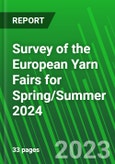The European yarn fairs for the spring/summer 2024 season were held in a hesitant spirit, reflecting the pressures facing the whole of the textile and clothing industry. In particular, the industry is being challenged by increasing legislative pressure as lawmakers push to enforce industry-wide regulation in a bid to realise the goals set out in the European Green Deal. Also, the industry is facing persistent inflationary pressure--in part as a result of the Russian invasion of Ukraine and subsequent war in the country, which caused European gas prices to soar to record highs in 2022.
Reflecting a somber mood that is being felt across Europe in light of these developments, the key colours for the spring/summer 2024 season are dark for the most part. In terms of fibre type, bast fibres and yarns are popular in the designs of collections for the season, and fibres derived from flax, hemp and nettle in particular are key. The popularity of bast fibres is a result of their desirable performance properties and environmental credentials. The latter is especially appealing in the context of the European Green Deal, which puts pressure on manufacturers to adopt environmentally sustainable principles and practices.
Also popular in the designs of collections for the spring/summer 2024 season are yarns produced using recycled waste materials--especially those made using polyester derived from waste plastic recovered from coastlines and the oceans. For many, it is thought that the practice of recovering waste plastic from the environment for use in the manufacture of textiles and clothing represents an act of environmental stewardship. However, exhibitors at the fairs faced some challenges about the accuracy of environmental claims relating to the use of such materials, given that synthetic fibres are known to be a cause of microplastics pollution.
Table of Contents
SUMMARY
INTRODUCTION
- Inflationary pressure
- Legislative pressure
- EU Strategy for Sustainable and Circular Textiles
- Corporate Sustainability Reporting Directive (CSRD)
- Waste Framework Directive (WFD)
YARN FAIRS
- Filo
- Pitti Immagine Filati
- Première Vision Paris
YARN TRENDS
- Colour
- Bast fibres and yarns
- Flax
- Hemp
- Nettle
- Polyester fibres and yarns
- The problem of waste plastic in the environment
- Yarns made using polyester derived from recycled ocean plastic
- Yarns made using polyester derived from plastic bottles
- Biodegradable polyester yarns








